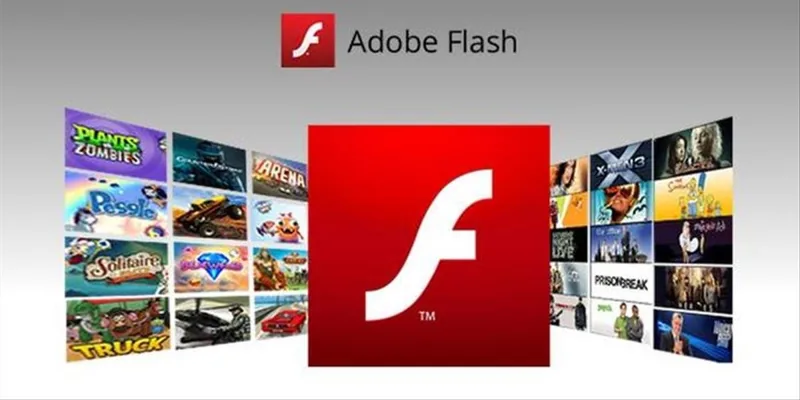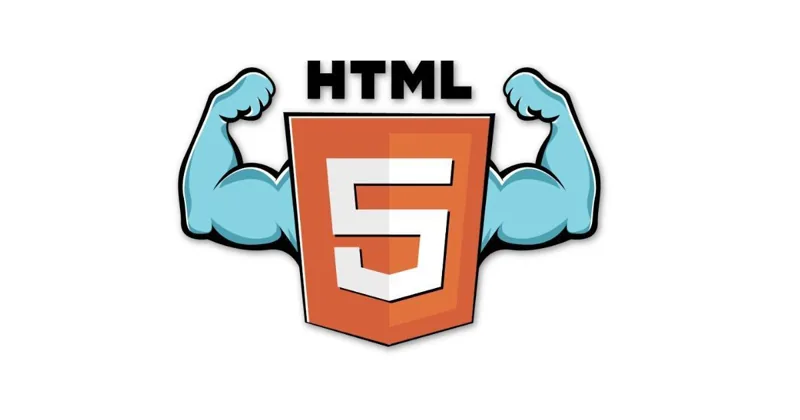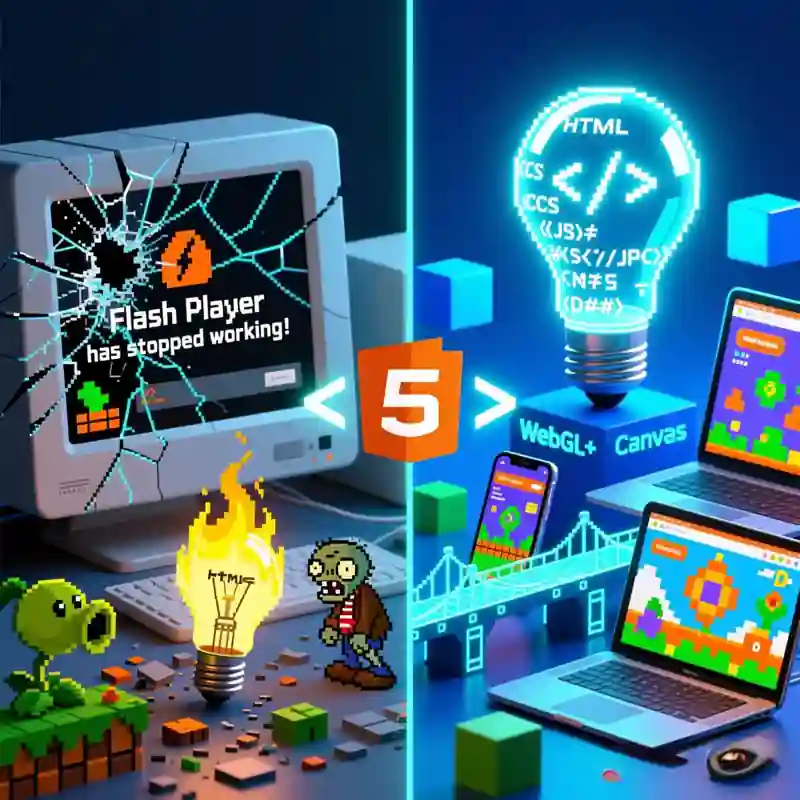On December 31, 2020, Adobe officially ended support for Flash Player, and all major browsers worldwide simultaneously blocked it completely. This moment marked the end of nearly two decades of the “Flash Era”—a time when countless web games, animations, and interactive applications shaped the childhood memories of the 80s and 90s generations. Overnight, these digital treasures became relics of a bygone era.
Yet, from the ashes of Flash, HTML5 emerged. Its open, efficient, and cross-platform nature not only brought web games back to life but also propelled the entire web ecosystem toward a more powerful, secure, and free future.
To truly understand this technological revolution, we need to examine why Flash was abandoned—a story shaped by technical shortcomings, market forces, and the inevitable evolution of the internet.
The Fall of Flash: Technical Flaws, Market Decisions, and the Inevitable Decline
Flash’s decline was gradual, driven by multiple pressures rather than a sudden collapse. Its obsolescence resulted from technical flaws, poor business decisions, and external market forces.

1. Technical Limitations: Performance, Security, and Closed Architecture
Performance issues and high resource consumption: Flash Player operated as an external plugin outside the browser’s native environment. Its rendering and script execution efficiency was significantly lower than modern web technologies. Playing complex animations or games taxed the CPU heavily, causing fans to spin and batteries to drain rapidly—especially on mobile devices. Modern web technologies, in contrast, leverage GPU acceleration for smooth, energy-efficient performance.
Frequent security vulnerabilities: Flash’s massive codebase and complex interactive features made it a prime target for hackers. Historically, Flash accounted for a large portion of browser security issues. Malicious websites exploited its vulnerabilities to install malware, steal user data, and even remotely control devices, earning Flash a reputation as a serious security risk.
Proprietary and closed nature: Flash was a closed, Adobe-owned ecosystem. Its file formats, protocols, and player were not open. This led to:
- Limited creative freedom: Developers were restricted to Adobe tools like Flash Professional and the ActionScript language, increasing the learning curve and limiting innovation.
- Compatibility challenges: Different browsers and operating systems often required updates, frustrating users with repetitive prompts.
- Poor integration and discoverability: Flash content acted as a “black box,” making it difficult for search engines to index or integrate seamlessly with other HTML content.
2. Market Forces: The Rise of Mobile and Apple’s Decision
In 2010, Apple released the iPhone and iPad, marking the start of the mobile-first era. Steve Jobs’ open letter, Thoughts on Flash, explicitly criticized Flash for poor performance, security issues, and subpar touch interactions, declaring that iOS would never support Flash.
This decision was transformative:
- Mobile-first reality: As more users accessed the web via smartphones and tablets, Flash’s incompatibility on iOS blocked a significant audience.
- User experience emphasis: Apple prioritized smooth, secure, and low-power experiences, directly highlighting Flash’s weaknesses.
- Market ripple effect: Following Apple’s lead, Google, Microsoft, and others gradually restricted Flash, culminating in its complete obsolescence.
3. Adobe’s Strategic Choice
Why didn’t Adobe modernize Flash to fit the new era? The reasons lay in technical debt, high redevelopment costs, and shifting business priorities:
- Heavy historical baggage: Flash evolved from a simple animation tool to a complex platform supporting video, games, and rich interactive applications. Fully modernizing it would have required a near-complete rebuild.
- Declining ROI: Adobe’s main business focused on creative software like Photoshop and Premiere. Maintaining a failing plugin consumed resources without sufficient return.
- Strategic pivot to open standards: Adobe wisely embraced HTML5. Flash Professional transformed into Animate CC, enabling creators to export content to HTML5 Canvas, WebGL, SVG, and more. This was less a resurrection of Flash and more a “rebirth of its spirit” in an open ecosystem.
HTML5’s Victory: Open, Efficient, and Ecologically Superior
Where Flash failed due to proprietary limitations, HTML5 thrived on openness, standards, and ecosystem growth.

| Dimension | Flash | HTML5 |
|---|---|---|
| Technical foundation | Proprietary plugin, requires installation | Open standard, browser-native support |
| Security | Frequent vulnerabilities, high risk | Sandbox architecture, higher security |
| Performance | CPU-dependent, inefficient | GPU-accelerated (Canvas/WebGL), efficient |
| Cross-platform | Poor mobile support, especially iOS | Fully compatible across PCs, mobile, and tablets |
| Accessibility & SEO | Closed content, hard for search engines | Indexed by search engines, SEO-friendly |
| Development cost | Requires Adobe tools, learning ActionScript | Uses universal tools (VS Code, editors), JavaScript language |
| Integration | “Black-box” plugin, limited interaction | Seamlessly integrates with HTML, CSS, JS; API-friendly |
User Experience: From Frustration to Seamless Play
- Flash era: Users frequently encountered “install Flash plugin,” “update required,” crashes, and annoying popups.
- HTML5 era: Games load instantly in the browser, run smoothly, and require no plugins. The experience is safe, fluid, and energy-efficient.
Developer Experience: From Restriction to Freedom
- Tool flexibility: Any code editor—from Notepad++ to VS Code—works.
- Unified language: JavaScript is a universal, well-documented language.
- Vast open-source ecosystem: Libraries and engines like Phaser, Three.js, and Unity WebGL accelerate development.
- Simple deployment: Upload files to a server, and they’re instantly accessible globally—no installation or app store approval needed.
Core Technologies That Revived Web Games
HTML5 isn’t a single technology but a collection of web standards. Key components that revived web games include:
1. canvas: 2D Drawing Surface
The <canvas> element provides a bitmap area for 2D graphics. With JavaScript, developers can:
- Draw sprites, backgrounds, and UI elements
- Animate frames and create particle effects
- Implement collision detection and physics simulations
Example: Classic games like Tetris or Pac-Man in browser versions are implemented using Canvas.
2. WebGL
WebGL allows direct GPU access for 3D rendering. Based on OpenGL ES, its low-level API provides high performance.
Example: 3D versions of Angry Birds, puzzle games inspired by Monument Valley, and simplified Minecraft clones run successfully in WebGL.
3. Web Audio API
Replacing Flash’s audio capabilities, Web Audio API provides precise control, supporting 3D audio, filters, and mixing for immersive sound experiences.
4. WebSocket
Enables real-time, bidirectional communication between browser and server, essential for multiplayer games like online card games or competitive real-time battles.
5. Web Storage
Stores game data (saves, settings, achievements) locally, preserving progress even when the browser is closed.
From Revival to Evolution: The Future of Web Games
HTML5 not only resurrected classic Flash games through emulators like Ruffle but also fostered new forms of gaming:
- PWA Games: Installable, offline-capable, with push notifications, offering near-native app experiences.
- Cloud Gaming: Leveraging WebRTC and server-side computing for “instant play” high-end experiences.
- Blockchain Games: Using Web3 to ensure true ownership of digital assets.
Emerging technologies promise even greater evolution:
- WebGPU: Next-generation graphics API with performance surpassing WebGL
- WebAssembly: Enables near-native execution speeds for complex games
- 5G/6G Networks: Ultra-low latency and high bandwidth further enhance the web gaming experience
With these advances, web games may soon rival or even surpass traditional client-based games in performance and interactivity.
The Triumph of Open Standards
The demise of Flash was not merely a technical failure; it was the collapse of a closed ecosystem in the face of open standards. Adobe’s decision reflected foresight—embracing HTML5 and open technologies rather than clinging to a fading platform.
Today, anyone can instantly play sophisticated 2D or 3D games on any device, often competing or collaborating with players around the world—all without installing a single plugin. HTML5 has not only revived web games but also redefined what a “game platform” can be. True technological progress is not measured by flashy effects alone, but by enabling more people, in more places, to enjoy creativity and entertainment at lower cost and with fewer barriers.






